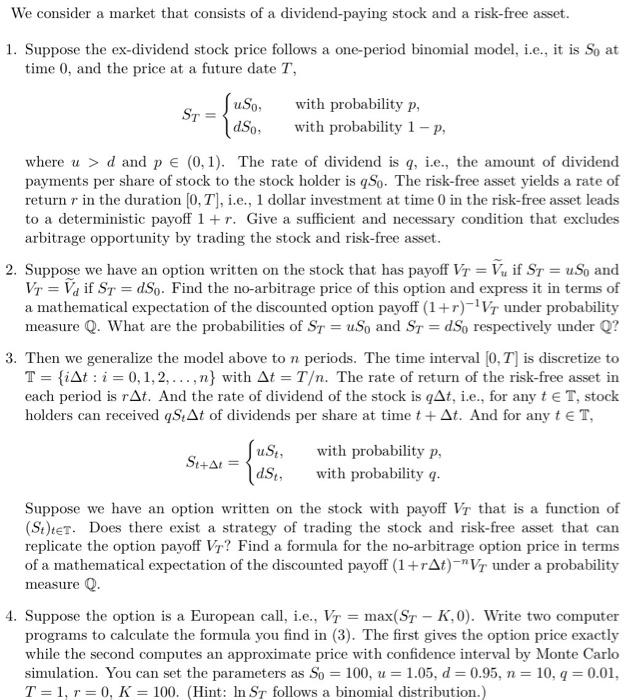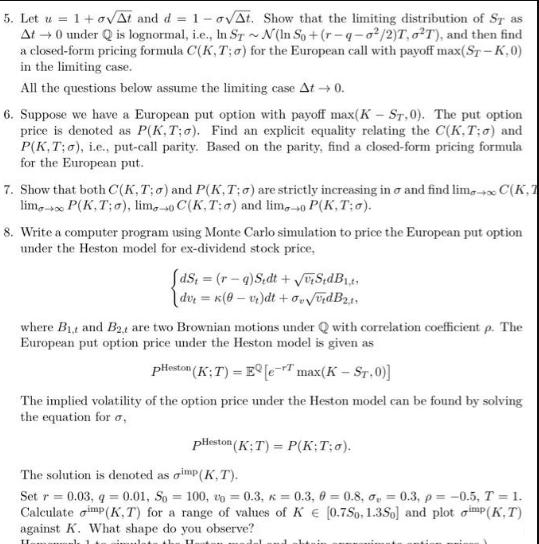Answered step by step
Verified Expert Solution
Question
1 Approved Answer
We consider a market that consists of a dividend-paying stock and a risk-free asset. 1. Suppose the ex-dividend stock price follows a one-period binomial


We consider a market that consists of a dividend-paying stock and a risk-free asset. 1. Suppose the ex-dividend stock price follows a one-period binomial model, i.e., it is So at time 0, and the price at a future date T, ST u.So, with probability p. dSo with probability 1-p, where u d and p = (0,1). The rate of dividend is q, i.e., the amount of dividend payments per share of stock to the stock holder is qSo. The risk-free asset yields a rate of return r in the duration [0, T], i.e., 1 dollar investment at time 0 in the risk-free asset leads to a deterministic payoff 1 + r. Give a sufficient and necessary condition that excludes arbitrage opportunity by trading the stock and risk-free asset. 2. Suppose we have an option written on the stock that has payoff Vr = Vu if ST = u.So and VTV if St = d.So. Find the no-arbitrage price of this option and express it in terms of a mathematical expectation of the discounted option payoff (1+r)-Vr under probability measure Q. What are the probabilities of ST = uSo and ST = d.So respectively under Q? 3. Then we generalize the model above to n periods. The time interval [0,7] is discretize to T = {i At i= 0, 1, 2,..., n} with At = T/n. The rate of return of the risk-free asset in each period is rAt. And the rate of dividend of the stock is qAt, i.e., for any t T, stock holders can received qStAt of dividends per share at time t + At. And for any t T, St+At = Just, d.St, with probability p. with probability q. Suppose we have an option written on the stock with payoff Vr that is a function of (St)teT. Does there exist a strategy of trading the stock and risk-free asset that can replicate the option payoff VT? Find a formula for the no-arbitrage option price in terms of a mathematical expectation of the discounted payoff (1+rAt)"Vr under a probability measure Q. 4. Suppose the option is a European call, i.e., VT = max(ST - K,0). Write two computer programs to calculate the formula you find in (3). The first gives the option price exactly while the second computes an approximate price with confidence interval by Monte Carlo simulation. You can set the parameters as So = 100, u = 1.05, d = 0.95, n = 10, q = 0.01, T= 1, r = 0, K = 100. (Hint: In ST follows a binomial distribution.) 5. Let u 1+At and d = 1-oAt. Show that the limiting distribution of ST as At 0 under Q is lognormal, i.e., In ST~ N(ln So+(r-q-o2/2)T, o2T), and then find a closed-form pricing formula C(K,T;o) for the European call with payoff max(ST-K,0) in the limiting case. All the questions below assume the limiting case At 0. 6. Suppose we have a European put option with payoff max(K- ST.0). The put option price is denoted as P(K.T;o). Find an explicit equality relating the C(K,T;o) and P(K,T:o), i.e.. put-call parity. Based on the parity, find a closed-form pricing formula for the European put. 7. Show that both C(K,T: a) and P(K,T:o) are strictly increasing in and find lime-C(K, 7 lim P(K,T; 0), lim, so C(K, T: a) and limeo P(K,T;0). 8. Write a computer program using Monte Carlo simulation to price the European put option under the Heston model for ex-dividend stock price, [ds,= (r-9) Sedt +SidB, dur= k(0-vr)dt + vdB,1 where B and B2, are two Brownian motions under Q with correlation coefficient p. The European put option price under the Heston model is given as pHeston (K;T) - Ele- max(K-ST.0)] The implied volatility of the option price under the Heston model can be found by solving the equation for o pHeston (K;T)=P(K;T;o). The solution is denoted as grimp(K.T). Set = 0.03, q=0.01. So= 100, v = 0.3, 0.3, 0 = 0.8, 0.3, p= -0.5, T = 1. Calculate (K, T) for a range of values of K [0.75o.1.35o] and plot (K,T) against K. What shape do you observe? minulat HI 2-1 hamin
Step by Step Solution
★★★★★
3.50 Rating (153 Votes )
There are 3 Steps involved in it
Step: 1
Answers to your questions 1 Arbitrage opportunity and noarbitrage condition An arbitrage opportunity exists if there is a trading strategy that guarantees a profit without any risk In this case with t...
Get Instant Access to Expert-Tailored Solutions
See step-by-step solutions with expert insights and AI powered tools for academic success
Step: 2

Step: 3

Ace Your Homework with AI
Get the answers you need in no time with our AI-driven, step-by-step assistance
Get Started


